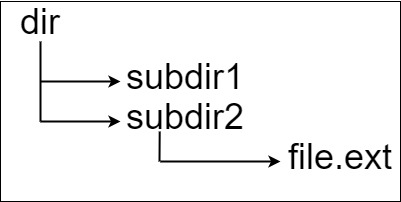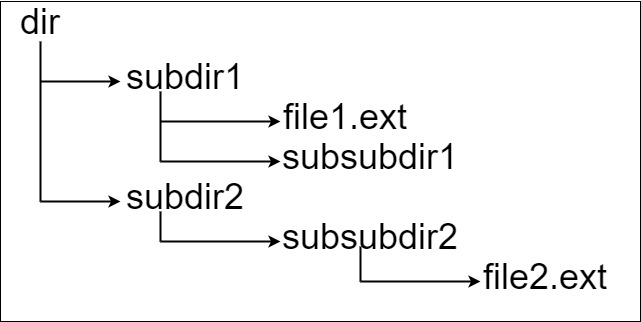原文链接: https://leetcode-cn.com/problems/longest-absolute-file-path
英文原文
Suppose we have a file system that stores both files and directories. An example of one system is represented in the following picture:

Here, we have dir as the only directory in the root. dir contains two subdirectories, subdir1 and subdir2. subdir1 contains a file file1.ext and subdirectory subsubdir1. subdir2 contains a subdirectory subsubdir2, which contains a file file2.ext.
In text form, it looks like this (with ⟶ representing the tab character):
dir ⟶ subdir1 ⟶ ⟶ file1.ext ⟶ ⟶ subsubdir1 ⟶ subdir2 ⟶ ⟶ subsubdir2 ⟶ ⟶ ⟶ file2.ext
If we were to write this representation in code, it will look like this: "dir\n\tsubdir1\n\t\tfile1.ext\n\t\tsubsubdir1\n\tsubdir2\n\t\tsubsubdir2\n\t\t\tfile2.ext". Note that the '\n' and '\t' are the new-line and tab characters.
Every file and directory has a unique absolute path in the file system, which is the order of directories that must be opened to reach the file/directory itself, all concatenated by '/'s. Using the above example, the absolute path to file2.ext is "dir/subdir2/subsubdir2/file2.ext". Each directory name consists of letters, digits, and/or spaces. Each file name is of the form name.extension, where name and extension consist of letters, digits, and/or spaces.
Given a string input representing the file system in the explained format, return the length of the longest absolute path to a file in the abstracted file system. If there is no file in the system, return 0.
Example 1:

Input: input = "dir\n\tsubdir1\n\tsubdir2\n\t\tfile.ext" Output: 20 Explanation: We have only one file, and the absolute path is "dir/subdir2/file.ext" of length 20.
Example 2:

Input: input = "dir\n\tsubdir1\n\t\tfile1.ext\n\t\tsubsubdir1\n\tsubdir2\n\t\tsubsubdir2\n\t\t\tfile2.ext" Output: 32 Explanation: We have two files: "dir/subdir1/file1.ext" of length 21 "dir/subdir2/subsubdir2/file2.ext" of length 32. We return 32 since it is the longest absolute path to a file.
Example 3:
Input: input = "a" Output: 0 Explanation: We do not have any files, just a single directory named "a".
Example 4:
Input: input = "file1.txt\nfile2.txt\nlongfile.txt" Output: 12 Explanation: There are 3 files at the root directory. Since the absolute path for anything at the root directory is just the name itself, the answer is "longfile.txt" with length 12.
Constraints:
1 <= input.length <= 104inputmay contain lowercase or uppercase English letters, a new line character'\n', a tab character'\t', a dot'.', a space' ', and digits.
中文题目
假设有一个同时存储文件和目录的文件系统。下图展示了文件系统的一个示例:

这里将 dir 作为根目录中的唯一目录。dir 包含两个子目录 subdir1 和 subdir2 。subdir1 包含文件 file1.ext 和子目录 subsubdir1;subdir2 包含子目录 subsubdir2,该子目录下包含文件 file2.ext 。
在文本格式中,如下所示(⟶表示制表符):
dir ⟶ subdir1 ⟶ ⟶ file1.ext ⟶ ⟶ subsubdir1 ⟶ subdir2 ⟶ ⟶ subsubdir2 ⟶ ⟶ ⟶ file2.ext
如果是代码表示,上面的文件系统可以写为 "dir\n\tsubdir1\n\t\tfile1.ext\n\t\tsubsubdir1\n\tsubdir2\n\t\tsubsubdir2\n\t\t\tfile2.ext" 。'\n' 和 '\t' 分别是换行符和制表符。
文件系统中的每个文件和文件夹都有一个唯一的 绝对路径 ,即必须打开才能到达文件/目录所在位置的目录顺序,所有路径用 '/' 连接。上面例子中,指向 file2.ext 的绝对路径是 "dir/subdir2/subsubdir2/file2.ext" 。每个目录名由字母、数字和/或空格组成,每个文件名遵循 name.extension 的格式,其中名称和扩展名由字母、数字和/或空格组成。
给定一个以上述格式表示文件系统的字符串 input ,返回文件系统中 指向文件的最长绝对路径 的长度。 如果系统中没有文件,返回 0。
示例 1:

输入:input = "dir\n\tsubdir1\n\tsubdir2\n\t\tfile.ext" 输出:20 解释:只有一个文件,绝对路径为 "dir/subdir2/file.ext" ,路径长度 20
示例 2:

输入:input = "dir\n\tsubdir1\n\t\tfile1.ext\n\t\tsubsubdir1\n\tsubdir2\n\t\tsubsubdir2\n\t\t\tfile2.ext" 输出:32 解释:存在两个文件: "dir/subdir1/file1.ext" ,路径长度 21 "dir/subdir2/subsubdir2/file2.ext" ,路径长度 32 返回 32 ,因为这是最长的路径
示例 3:
输入:input = "a" 输出:0 解释:不存在任何文件
示例 4:
输入:input = "file1.txt\nfile2.txt\nlongfile.txt" 输出:12 解释:根目录下有 3 个文件。 因为根目录中任何东西的绝对路径只是名称本身,所以答案是 "longfile.txt" ,路径长度为 12
提示:
1 <= input.length <= 104input可能包含小写或大写的英文字母,一个换行符'\n',一个制表符'\t',一个点'.',一个空格' ',和数字。
通过代码
高赞题解
解题思路
【思路】
用split(‘\n’) 将原串分割开,相当于一次读一行
利用字符串前面’\t’的个数来当前目录/文件在第几层。第一层0个,第二层在split(‘\n’)后前面就有一个\t…以此类推
利用一个前缀和数组把前面几层的字符串长度都记下来,每次计算到包”.”的文件时,说明到底了,更新下结果,再继续下一个计算,把数组前面的值覆盖掉
例子:”dir\n\tsubdir1\n\tsubdir2\n\t\tfile.ext”
第一步分割成下面这样子dir \tsubdir1 \tsubdir2 \t\tfile.ext第二步计算它在第几层,以及它的长度是多少
代码
class Solution {
public int lengthLongestPath(String input) {
if (input.length() == 0) {
return 0;
}
int res = 0;
int[] sum = new int[input.length() + 1]; //从1开始,第0层就是0
for (String s : input.split("\n")) {
int level = s.lastIndexOf('\t') + 2; // 计算当前在第几层(从第一层开始,没有\t就是第一层)
int len = s.length() - (level - 1); // 计算当前这一行的长度
if (s.contains(".")) {
res = Math.max(res, sum[level - 1] + len);
} else {
sum[level] = sum[level - 1] + len + 1; //是目录,要+1,目录有个/的
}
}
return res;
}
}统计信息
| 通过次数 | 提交次数 | AC比率 |
|---|---|---|
| 6753 | 12673 | 53.3% |
提交历史
| 提交时间 | 提交结果 | 执行时间 | 内存消耗 | 语言 |
|---|



